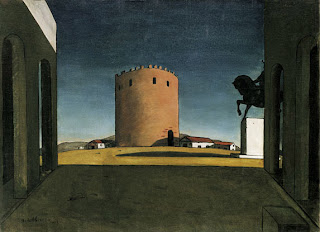The Museums of Venice
For a tiny conglomeration of islands that measures only two miles in one direction and one mile in the other, Venice has an extraordinary amount of world-class art per square inch. If San Francisco had even one tenth of the art available daily in Venice, I would be over the moon with joy. Not to mention that the buildings that house this treasure trove of art are some of the most beautiful palaces in the city, built during the extravagant heyday of Venice's glory.
I did not go to all of the museums. That would not have been possible in a single week. I decided to choose my haunts carefully, based on my interests and not merely upon the most famous sights. So I skipped the Accademia and some of the more religious-based museums and churches in favor of more modern works and museums that explore the history of the city. I was not disappointed in any of my choices. My first stop in Venice was the Peggy Guggenheim Collection, in our local sestiere of Dorsorduro, the day after our arrival. This visit was probably the closest thing to a pilgrammage for me, artwise. I had been intrigued by The Red Tower, a painting by Giorgio de Chirico, after having seen the work in an art history class my freshman year in college. For some reason, that painting had stayed with me, even though my only exposure to it had been a 2-inch representation in a thick art book. Now I had my chance to see the real thing, and I made a beeline for the painting when I entered the museum.
My first stop in Venice was the Peggy Guggenheim Collection, in our local sestiere of Dorsorduro, the day after our arrival. This visit was probably the closest thing to a pilgrammage for me, artwise. I had been intrigued by The Red Tower, a painting by Giorgio de Chirico, after having seen the work in an art history class my freshman year in college. For some reason, that painting had stayed with me, even though my only exposure to it had been a 2-inch representation in a thick art book. Now I had my chance to see the real thing, and I made a beeline for the painting when I entered the museum.
It is a unique and singular experience to see up close and in person a work of art that you admire (even if you are not sure exactly why you like it). Only then, does the work truly become art. When you stand in front of the piece, whether it is a painting, sculpture or  something else entirely, there is a physical sensation that makes you appreciate and understand what the artist was trying to communicate. In those same circumstances did I understand the greatness of the Mona Lisa, and the genius of Van Gogh.
something else entirely, there is a physical sensation that makes you appreciate and understand what the artist was trying to communicate. In those same circumstances did I understand the greatness of the Mona Lisa, and the genius of Van Gogh.
During my visit to the Guggenheim, I also had a chance to see a charming painting, Empire of Light, by another favorite artist, René Magritte, and be introduced to the works of Max Ernst, Guggenheim's husband and a sensitive artist who was obviously somewhat deranged. This particular painting, The Attirement of the Bride, was fascinating and nightmarish and very personal, given that the bride is Peggy Guggenheim herself and the circumstances of the imagery are certainly disturbing.
This particular painting, The Attirement of the Bride, was fascinating and nightmarish and very personal, given that the bride is Peggy Guggenheim herself and the circumstances of the imagery are certainly disturbing.
The next museum I enjoyed thoroughly was the Palazzo  Fortuny, a large Gothic palazzo in Campo San Beneto, which was transformed by designer Mariano Fortuny into his own atelier of photography, stage-design, textile-design and painting.
Fortuny, a large Gothic palazzo in Campo San Beneto, which was transformed by designer Mariano Fortuny into his own atelier of photography, stage-design, textile-design and painting.
The museum itself is very enigmatic. It is more of an atmosphere and a presence than a place to see a certain piece of art. Fortuny is best known for his textiles and silks , but this is by no means a costume museum.
The only fabrics of his design cover the walls on the second floor atelier, giving the large room the feeling of an opium den or a Sultan's lair.  The main room is partially filled with strange and macabre artifacts and curiosities, and is best visited when you are in a mood to be slightly disturbed, and wanting to enjoy the feeling of otherworldliness.
The main room is partially filled with strange and macabre artifacts and curiosities, and is best visited when you are in a mood to be slightly disturbed, and wanting to enjoy the feeling of otherworldliness.
The other modern art collection, Ca' Pesaro, is located 
Although the exterior of the building retains its classic Venetian appearance, inside is a treasury of Impressionist and modern artists.
I have finally had the chance to see a Gustave Klimt painting, Salome, in person. It was large, framed in gold leaf, full of lust and glorious to behold. I visited it three times while I was in the museum, wanting to take full advantage of it while I was there.
Nearby to Ca' Pesaro was a smaller--but no less fascinating--museum, Palazzo Mocenigo. From Fodors (because they described it better than I could): So well preserved it looks like a movie set, this palazzo gives a sense of how wealthy families lived in the last years of the republic. Bequeathed to the city in 1945 by the last surviving Mocenigo heir, the home is richly decorated with polished floors, fabric-covered walls, and glass chandeliers from Murano.
The portego (entry hall), typical of Venetian palazzos, occupies about one-third of the total  floor space; once used for receptions and balls, it now occasionally hosts classical concerts. Sparsely furnished, it's lined with portraits of the seven Mocenigo family doges and other notables.
floor space; once used for receptions and balls, it now occasionally hosts classical concerts. Sparsely furnished, it's lined with portraits of the seven Mocenigo family doges and other notables.
Doors on both sides of the portego open onto bedrooms and salons, where visitors were received with a cup of hot chocolate in the early morning hours after nights typically spent at parties or seated at gambling tables. Furniture and paintings are all original and constitute a permanent exhibit. The mannequins' clothing, lace, fabrics, and accessories on display come from the Center for the History of Textiles and Costumes (housed in a wing of the palace) which organizes 15th- to 18th-century thematic exhibits.

In addition to the myriad painted ceilings, portraits, gold leaf and fantastic furniture, are the most divine Murano chandeliers still in existence. The craftsmanship of everything in the palazzo is stupefying, but the glasswork, to me, were the most dazzling creations of all. Of course you are not allowed to take pictures in this or any of the museums but I found a company that makes reproductions of the chandeliers at Ca' Rezzonico. This picture should give you an idea of what they looked like, if not the grandeur, scale and color of the originals.
Of course you are not allowed to take pictures in this or any of the museums but I found a company that makes reproductions of the chandeliers at Ca' Rezzonico. This picture should give you an idea of what they looked like, if not the grandeur, scale and color of the originals.

In 







0 comments:
Post a Comment